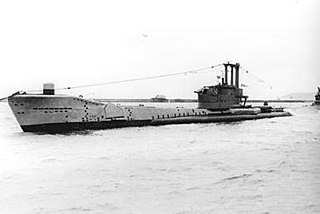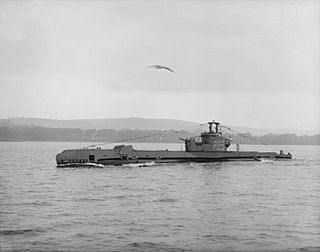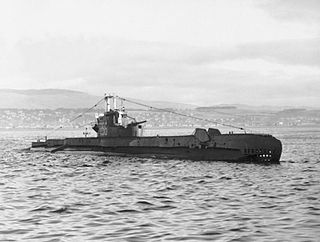
HMS Astute (P447) was an Amphion-class submarine. Her keel was laid down by Vickers at Barrow-in-Furness. She was launched in 1944 and commissioned in 1945.
HMS A2 was an A-class submarine built for the Royal Navy in the first decade of the 20th century.

HMS A6 was an A-class submarine built for the Royal Navy in the first decade of the 20th century.

HMS A10 was an A-class submarine built for the Royal Navy in the first decade of the 20th century. After surviving World War I, she was sold for scrap in 1919.

HMS A9 was an A-class submarine built for the Royal Navy in the first decade of the 20th century. After surviving World War I, she was sold for scrap in 1920.
HMS Acheron (P411) was an Amphion-class submarine of the Royal Navy, laid down 26 August 1944, launched 25 March 1947 and completed in 1948.
HMS Alaric (P441), was an Amphion-class submarine of the Royal Navy, built by Cammell Laird laid down in May 1944 and launched 18 February 1946.

HMS Alcide (P415), was an Amphion-class submarine of the Royal Navy, built by Vickers-Armstrongs and launched 12 April 1945.

HMS Alderney (P416/S66), was an Amphion-class submarine of the Royal Navy, built by Vickers-Armstrongs at Barrow and launched 25 June 1945 by Mrs Molly Wallis, wife of Sir Barnes Wallis. She was the 12th of the class and was scrapped in 1972.
HMS Ambush (P418/S68/S18), was an Amphion-class submarine of the Royal Navy, built by Vickers Armstrong and launched 24 September 1945.

HMS Andrew (P423/S23/S63), was an Amphion-class submarine of the Royal Navy, built by Vickers Armstrong and launched on 6 April 1946.

HMS Amphion (P439), was an Amphion-class submarine of the Royal Navy, built by Vickers Armstrong and launched 31 August 1944.
HMS Anchorite (P422/S22), was an Amphion-class submarine of the Royal Navy, built by Vickers Armstrong and launched 22 January 1946.

HMS Artful (P456), was an Amphion-class submarine of the Royal Navy, built by Scotts Shipbuilding and Engineering Company of Greenock and launched 22 May 1944.
HMS Artemis (P449) was an Amphion-class submarine of the Royal Navy, built by Scotts Shipbuilding & Engineering Co. of Greenock and launched 28 August 1946. The submarine sank while refueling in 1971, was raised and sold for breaking up in 1972.
HMS C35 was one of 38 C-class submarines built for the Royal Navy in the first decade of the 20th century.

HMS Sea Scout was a S-class submarine of the third batch built for the Royal Navy during World War II. She survived the war and was sold for scrap in 1965.

HMS Seneschal was a S-class submarine of the third batch built for the Royal Navy during World War II. She survived the war and was sold for scrap in 1965.

HMS Sentinel was a S-class submarine of the third batch built for the Royal Navy during World War II. She was not completed until after the war and was sold for scrap in 1962.
HMS L26 was a L-class submarine built for the Royal Navy during World War I. The boat was not completed before the end of the war and was one of three L-class boats to serve during World War II. She was sunk as a target in 1946.












